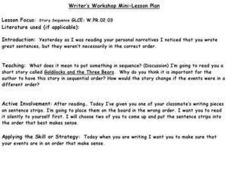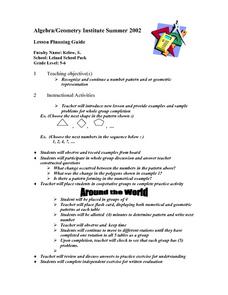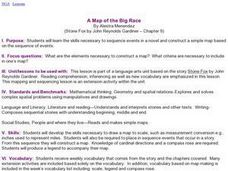Curated OER
Worksheet: Ordering Decimals and Fractions
In this ordering decimals and fractions worksheet, students rewrite fractions in the same unit and then place them in sequential order. A "how to" example is given, with step by step instructions. Eight problems are provided. Students...
Curated OER
Finding The Sequence
In this math worksheet, students look for the numbers that are used to complete the sequence of numbers. They also write down the rule for the 20 questions.
Curated OER
Writers Workshop Story Sequence
Students read stories and explore the importance of sequential order. In groups, students are given sentence strips. Students holding the sentence strips, place themselves in a logical order to make a story. Individually, students...
Curated OER
Sequence of Events
Third graders discuss the importance of putting events into the correct sequence. In groups, they put the order of events of different stories into the correct order while completing a worksheet. To end the lesson, they identify the...
Curated OER
Finding The Sum of an Infinite Series
Students examine finding the sum of an infinite series as the limit of partial sums. Through hands-on activities, students create their own sequence by finding the area of a square and then cutting it in half-sized pieces. They write...
Curated OER
Taming the Wild Aurochs
Fourth graders assess the development of animal husbandry, outline it in detail as well as arrange the steps in sequential order. In addition, they discuss how certain animals came to be domesticated, concentrate to research on one of...
Curated OER
Patterns and Geometric Representations
Students explore patterns and sequences. Given an example of each, they discuss their observations. In groups, students participate in an "Around the World" activity where they rotate to different stations in the classroom to determine...
Curated OER
Patterns
Fifth graders investigate the use of patterns in a data set. The set is disolayed visually using cubes. This helps struggling students to see the quantity in order to make comparisons more effectively.
Curated OER
Social Studies: Personal Chronology
Fourth graders draw ten significant events from their lives on index cards, shuffle them, and trade sets with other students. Their classmates try to place them in chronological order. Next, 4th graders tape their index cards next to...
Curated OER
2, 4, 6, 8 . . .What Do We Appreciate-Patterns, Patterns, Patterns
Students discover and predict patterns in a numerical sequence. Through the Internet and video segments, students begin with basic number patterns and extend their knowledge into higher math skills. They will also create new patterns...
Curated OER
Fibonacci Numbers
Students calculate the Fibonacci sequence of numbers. Through the use of Fibonacci numbers in flowers, leaves, fruits, vegetables, pine cones, and other forms of nature; students explore how Fibonacci numbers occur in nature. Then they...
Curated OER
Getting Down and Dirty: An Exploration of the 1930's
Pupils complete an exploration of the 1930s. Using artwork and primary source documents, they compare, contrast and identify cause and effect relationships in the events of the decade. They discover how the events then affect people...
Curated OER
Tukutuku Patterns
Young scholars complete a series of lessons involving Tukutuku patterns, their rotations and area formulae. They determine the algebraic formulae for sequences. They use images as they work through the lessons to find the number of...
Curated OER
Scatter Cat!
First graders read the story Hairy MacLary, Scatter Cat by Lynley Dodd, to provide a context in which to use the language of movement and position and to provide opportunities to move themselves as they act out parts of the story.
Curated OER
Logical Sequence
Students examine logical and illogical sequences in writing. They identify illogical sequences of sentences in a letter. Students retell short stories using a logical sequence and students place sentences in logical order.
Curated OER
Introduction to Arithmetic and Geometric Sequences
Students examine the concept of sequences. Students create a sequence using varied starting numbers, multipliers, and add on values. Students practice determining the starting values to use in order to produce a desired sequence.
Curated OER
Sequences and Exponents
Students practice multiplication sequences and multiplying with exponents. They study how a sequence is a set of numbers which follows a mathematical rule and can be used with all four operations and with combinations of operations.
Curated OER
Snowman in Winter Sequence Writing
Students develop a creative snowman using step-by-step stickers. They write a short story about the snowman they have created, explaining the sequence they used to create their snowman. Students present their completed story in front of...
Curated OER
A Map of the Big Race
Students read a novel and practice putting the events into the correct sequence. Using the text, they create a map showing the events of the race in order and a legend. They must use vocabulary from previous chapters and make their map...
Curated OER
Sequencing
Second graders practice their ability to sequence different events. Using a story, they put the events of a chapter book into order by cutting the events out and pasting them on a separate piece of paper. As a class, they repeat a...
Curated OER
Guided Reading -- If You Give a Mouse a Cookie
Students are read the book "If You Give a Mouse a Cookie" page by page and discuss their favorite types of cookies. They predict what they believe will happen next based on what has already happened in the story. They practice putting...
Curated OER
Technical Literacy
Students explore the components of the transference of technological information through this ten instructional activity unit. The applications to specific careers, the determination of responsible use of technology, and the affects of...
Curated OER
Patterns and Sequences
Sixth graders explore pattern recognition and sequencing. They create arithmetic and geometric sequences with colors, shapes, and numbers. Students write expressions of arithmetic sequences and geometric sequences to find the nth term.
Curated OER
Shell Sort; Serving up Seafood
Students complete various small group activities to classify items and determine the types of combinations that can be made with these items. In the second lesson, students create menus for a restaurant to help them gain money sense and...

























